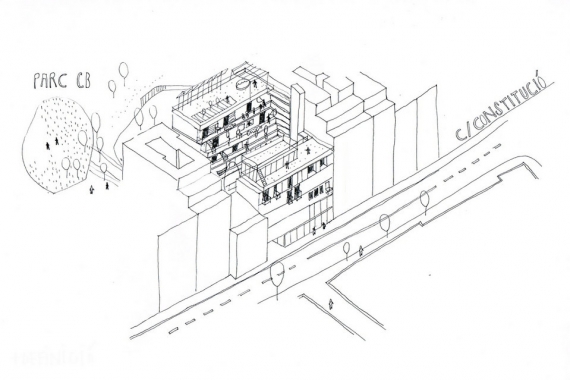Learning from each other: Catalonia meets Denmark
Scanning innovation in housing policies (1/3)
Barcelona, 16 June 2014 | Social, Urban, Economy
The Andel cooperative housing model originating in Denmark and now emerging in southern Europe is a community-based approach to housing policies
By Eduard Cabré Romans and Arnau Andrés Gallart*
Housing Cooperatives which provide housing under a cession of use scheme have already been developed in northern European countries such as Denmark, Norway and Sweden, as well as in Uruguay or Canada, for some years now. The Danish model, also known as the Andel model, has been recently disseminated in Catalonia (Spain) by the non-for-profit association Sostre Cívic. As a member of the association, Raül Turmo argues that the Andel model has hardly been applied in Catalonia despite fitting in the current legal framework. On the contrary, housing cooperatives have traditionally worked as developers of housing destined for sale and not as managers of affordable housing.
The main features of the Andel model can be summarized as follows:
Read More- The model is based in the private initiative of non-for-profit cooperatives that develop and manage housing for their members.
- The cooperatives are made up by the partners, who have the indefinite right to use one of the dwellings as long as they are members of the cooperative. This right can even be left in bequest. The dwelling can also be sublet to a third person for a limited period of time.
- The right to use the dwelling is acquired by paying an entry fee that is proportional to the surface of the dwelling and will be returned in case of leaving the cooperative.
This right is kept by paying an affordable and adaptable monthly fee intended to cover the cost of the debt contracted in order to develop the housing promotion (land and construction or rehabilitation) and for the maintenance of the building and the cooperative. The sale price of the right is agreed by the cooperative as a whole and takes into account the improvements or maintenance costs attributable to the previous tenant. This system triggers a proper maintenance of the home by its tenant and avoids real estate speculation.
- User partners participate in all the cooperative decision-taking processes through the assembly. Different communal living settings can be arranged between households. This system makes people jointly responsible for the development of the cooperative and the maintenance of the buildings.
- Housing cooperatives can be developed both in public and private land, in the free or in the publicly intervened housing market. Both the cession and the transmission of the surface right of public land for a long period of time are considered the best arrangements as long as they contribute to the affordability of housing without forcing public administrations to give up their land assets.
The Andel model is thus a non-speculative affordable housing model that takes housing as a basic commodity rather than a merchandize in the framework of a consolidated capitalist economy. Its social advantages lay in the fact that affordability is one of the core pillars of the model, although the participation of public administrations via public subsidies to some cooperatives increases their commitment to granting housing for all. In terms of tenancy, it tries to improve housing accessibility through mixing the advantages of renting and ownership. Proponents of cooperatives also point to financial advantages stemming from economies of scale, that derive from the fact that the mortgage is held by the cooperative rather than by individuals.
As Raül Turmo stresses: “the implementation of this model has more to do with a cultural change than with a legislative change”. Nevertheless, it has received preferential treatment from the government in some of the countries where it has been consolidated. Public administrations can, for instance, take part on a cooperative as a member and devote their dwellings to social housing policies, avoiding at the same time the creation of ghettos that other policies may cause. They can also introduce favourable land regulations that encourage people to organize in housing cooperatives. In any case, even if it has been said that the current legal framework allows for the creation of such housing cooperatives, there is not a clear-cut regulation of these cooperatives that can prevent them from being privatized.
Whether under the guardianship of public administrations or not, there are some cases of on-going projects of housing cooperatives inspired in the Andel model in Catalonia. Cooperativa d’Habitatges La Mangala, in Can Batlló (Barcelona), is one of them.
* Eduard Cabré Romans is a researcher at the European Social Housing Observatory of CECODHAS Housing Europe. Arnau Andrés Gallart is an architect involved in the development of Cooperativa d’Habitatges La Mangala in Can Batlló (Barcelona).
Leave comments